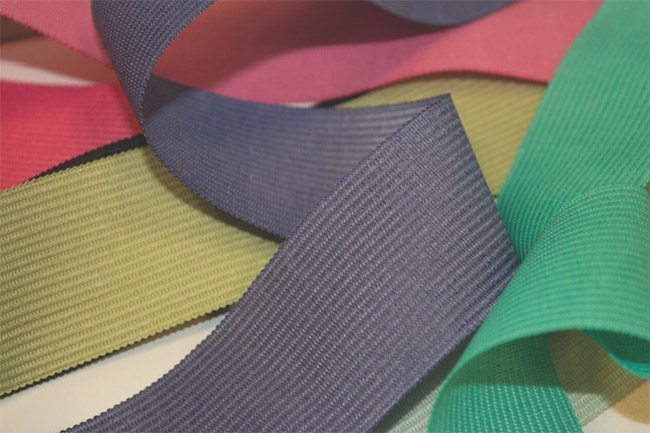
Designers at Paterson, New Jersey-based Reliant Ribbon & Trims Corp. assembled this mélange of narrow fabric constructions in ever-popular gray, black and white hues.
BY BARBARA T. NELLES
Binding tape and ribbon may be among the last items considered when designing a mattress collection, but they couldn’t play a more important role in completing the look of a bed.
Today, design teams get to choose from hundreds, if not thousands, of narrow fabrics and trims in myriad colors and designs to close seams, decorate bed borders and gussy up point-of-sale items.
This wasn’t always the case. As recently as the 1990s—remember then?—narrow fabrics used in mattress construction were purely functional, 1-inch-wide seam closers in white or ecru. They provided a strong, finished edge—and that was it.
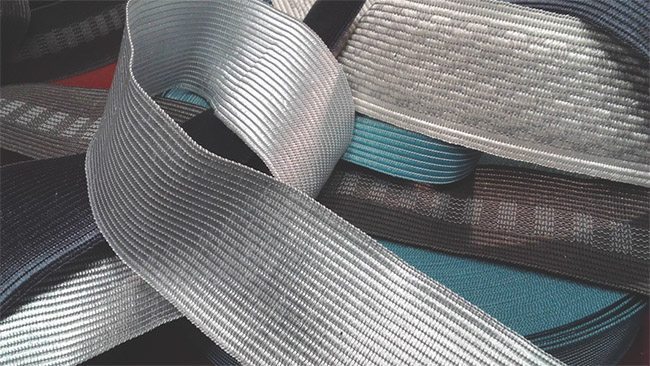
Mattress designers say that gray accents are here to stay—at least through 2017—and Bechik Products Inc., headquartered in Eagen, Minnesota, adds some shine with solid, glossy tapes the company says are ‘flying out the door.’
With the rise of specialty sleep and cut-and-sewn covers, many mattresses today have no tape-edge. In fact, some of the newest covers have no visible seams at all, save at the corners. Yet, many of these presewn covers incorporate narrow fabrics for both decorative and utilitarian purposes. (More about that later.)
When it comes to putting a bed together the old-fashioned way, where a tape-edge-machine operator joins the bed’s border material to the panel, the use of binding tape is routine. While a traditionally manufactured mattress can be sewn up without a tape-edge, “it sure wouldn’t be pretty,” says Bill Simon, president of Eagen, Minnesota-based Bechik Products Inc. “It’s there to finish the look of that edge, as well as to seal it up and prevent any fray.”
Border battle—knits vs. wovens
In the beginning, all mattress tapes were woven. Then, some 15 years ago, the industry’s largest tape supplier, CT Nassau, introduced knit versions.

Bo-Buck Mills Inc., based in Chesterfield, South Carolina, recently introduced a collection of woven tapes with a subtle hexagonal design.
“Knits and wovens provide two different aesthetics,” says Taber Wood, national account director for CT Nassau Tape-Ticking LLC, based in Alamance, North Carolina. “You can be more decorative with woven designs, but knits offer more movement and stretch and, since you can get by with less (yarn) weight, they can be less expensive. Knits also allow for the use of more extravagant yarns, like chenille and Taslan” (a polypropylene air-textured yarn).
All of the tape suppliers BedTimes spoke with offer both woven tapes (produced on a loom) and knit tapes (produced on knitting machines).
“Wovens are stronger,” says Gary Richert, chief executive officer of Bo-Buck Mills Inc., with headquarters in Chesterfield, South Carolina. “The typical woven tape requires 300 pounds to 420 pounds of pressure before it snaps. With knits, it’s between 20 pounds and 100 pounds.”
Suppliers say preferences for the two constructions are cyclical. A current trend is to add a bit of shine or bulk to the border, using a solid-color knit with plenty of polypropylene yarn.
Currently, CT Nassau produces and sells more wovens than knits, Wood says, “but knits have come on strong again due to this growing preference for solid colors and the fact that knits have some stretch, which means they work better with popular adjustable bed bases.”

CT Nassau Tape-Ticking LLC, based in Alamance, North Carolina, creates drama for the bed border by pleating a thick, glossy black narrow fabric flecked with white.
Simon says the movement toward solid-color knits got its start in 2015, and tape displays at ISPA EXPO 2016 in March in Orlando, Florida, cemented the trend. But woven tapes in many popular looks continue to be strong sellers, too.
“We’ve had great success with our Craft Wovens introduced at ISPA EXPO 2014,” Simon adds. “It offers subtle color variations and texture. The idea is to create a tape you might see on a piece of upholstered furniture.”
While woven tapes are flatter in terms of depth, they can incorporate extremely ornate or fine designs, Richert says. “Currently, about 80% of Bo-Buck Mills’ production is woven, but up until 2002, the split was about 40% knits and 60% wovens. Knits offer better sheen, but they don’t accept dye and printing as well as the wovens.”
From the ‘Dark Ages’ to bright spots
Narrow fabric suppliers tout their globe-trotting design teams, which attend international fairs and educational events to stay abreast of fashion and product design trends.
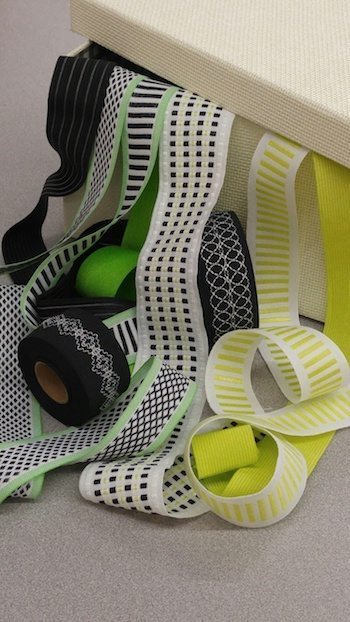
AEC Narrow Fabrics, based in Asheboro, North Carolina, offers knit and woven tapes with bright and neon touches as a complement to some of today’s stark black-and-white mattress designs.
Yet, there is no denying that the mattress industry’s five-year fascination with gray—from light silver to pewter to gunmetal—shows no sign of waning. Expect to see the look continue at least through 2017, tape suppliers say. “We do see a warming trend happening,” says Laura Allred, product manager for Asheboro, North Carolina-based AEC Narrow Fabrics. “Grays are transitioning to a taupe—think of the gray-beige, weathered-furniture look. I’m getting a lot of requests for that palette, as well as gray warmed with shades of lilac and lavender.”
Beyond gray, another strong look is stark black and white. Suppliers are selling solid black tapes, some with texture and shine, as well as a lot of black-and-white tapes with geometric motifs.
Dark navy also is trending, but the mattress industry finally is giving brown a rest. Lighter blues and greens—the “spa colors”—continue to be popular accents, especially when the bed comes with a cooling or gel story.
New Day-Glo accent colors are coming from the “ath-leisure” apparel trend, Allred says. “Think of those neon athletic shoes everyone wore at the Olympics or the current ‘fitness fashion’ trend, where people wear vivid workout clothes in stretchy comfort fibers, even if they’re not working out. On beds, we are seeing manufacturers use touches of bright orange and lime-green, as well as pops of bold primaries like red and blue. These work especially well with some of the black-and-white design schemes.”
When it comes to motifs, suppliers offer everything from classic bar tape to an enormous range of intricate designs, such as pin-checks and latticework.
Decorator touches
When is a “mattress tape” a “ribbon” and vice versa?
“Many in the industry don’t think of ribbon as mattress tape, but they are made much the same way,” says Scott Smith, executive vice president of sales for Reliant Ribbon & Trims Corp., headquartered in Paterson, New Jersey.
Jeff Miller, senior vice president of BRK Tape & Textiles, with headquarters in Pico Rivera, California, says, “Generally, the difference between a closing tape and a ribbon is one of function, not construction. The same product can be used for both. If it closes a mattress, it’s tape; if it wraps around the border, it’s a ribbon.”
There are some caveats.
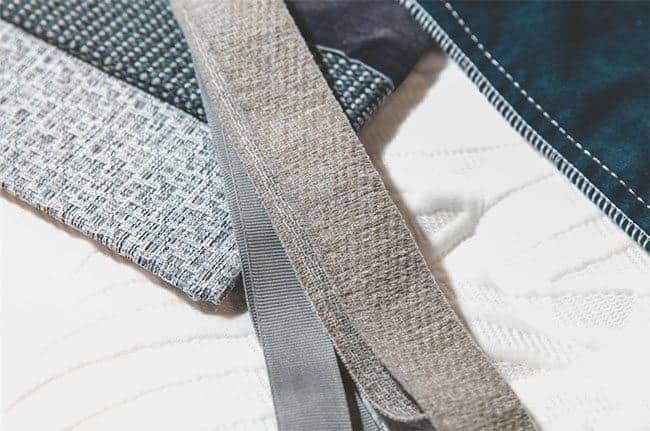
Solid-colored tapes with a little more bulk or a softer texture—such as this taupe option from BRK Tape & Textiles in Pico Rivera, California—are trending on some of today’s well-embellished beds.
“With decorative ribbons, we have more flexibility in design,” Allred says. “They can be thicker and more elaborate and embellished with specialty yarns. They don’t have to have the same strength, but we produce them on the same machinery and with the same basic yarns. But some of our decorative ribbons are exactly the same quality as a closing tape; they just have a different width.”
Sealy kick started the use of narrow fabric as a more decorative element in 2011 when it added a horizontal mattress handle made from tape, Richert says. It encircled the perimeter of its Posturepedic models and, from a distance, looked simply like ribbon trim. The trend solidified the following year when Serta rolled out a logo-emblazoned satin ribbon on the border of its iSeries models.
“The use of printed ribbon and custom jacquard ribbon gives manufacturers the opportunity to communicate a brand name or logo,” Smith says. “They can make beds stand out on a crowded sales floor, or can differentiate mattress models within a single collection.”
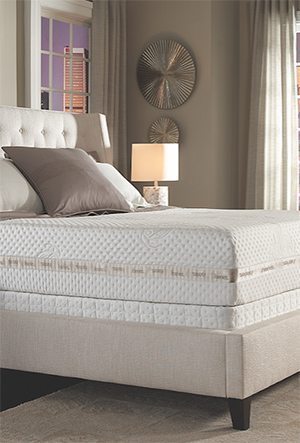
In 2012, the Serta brand, with headquarters in Hoffman Estates, Illinois, introduced iSeries mattresses with a wraparound, branded satin ribbon on the border.
And then there are mattress handles, which are sewn from mattress tape and often decorated with multiple narrow fabrics.
“Ribbon is used everywhere on the border and at the point of sale because it’s a great way to tie point-of-purchase items into the bed design,” Smith says. “Mattress manufacturers have gotten very sophisticated about this.”
These days, ribbons edge POP headboards, act as gussets for pillows and adorn product-information cardholders on foot guards. In addition, a lot of ribbon is being used to brand specific models for specific retailers. “It’s not something you may see at the furniture markets, but we are selling a lot of tape and ribbon for that purpose,” Allred says.
“We’re happy to see that mattress tape is finding its way back into cut-and-sewn mattress covers,” Wood adds. “Manufacturers are using tapes to ID their product lines through the use of color or adding a brightly colored tape to hide a zipper and act as a design element at the same time.”
With cut-and-sewn covers, tapes can act as a transition fabric, as well as an accent, between the zipper and the ticking, Allred says. “Or they can go between the border fabric and the panel. If you’re sewing a stretchy panel to a less stretchy border, we can create a low-stretch, elastic narrow fabric that acts as a transition. AEC has the capability to do this because of our experience in the apparel industry.”
Narrow fabrics used as design elements are here to stay, Miller says. “You can get a big impact for little cost. The other thing that’s happened is that there is a wide range of machinery in place for sewing decorative borders and handles,” he says. “Manufacturers have the ability to sew their own narrow fabrics onto bed borders, so they’ll always consider it.”
ISPA member supplier profiles
AEC Narrow Fabrics
-
Headquarters: Asheboro, North Carolina
-
Contact: Laura Allred, product manager
-
Phone: 336-629-2626
-
Email: [email protected]
-
Website: AECNarrowFabrics.com
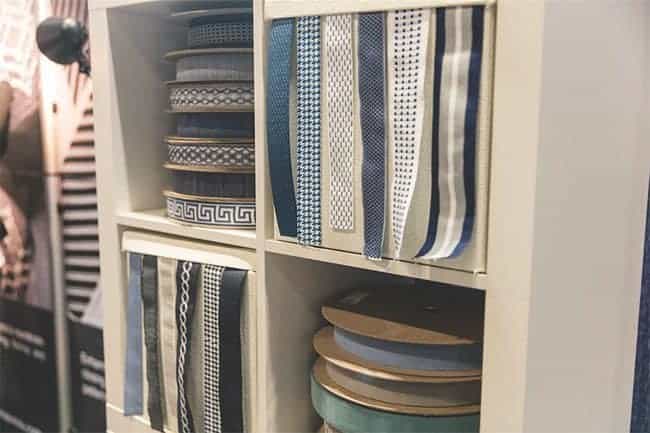
At ISPA EXPO 2016, Asheboro, North Carolina-based AEC Narrow Fabrics displayed knit and woven tapes in navy and denim, plus soft chenille tape (lower right) that can be pad-dyed to customer specifications.
Asheboro, North Carolina-based AEC Narrow Fabrics observes a milestone this year as it celebrates its 30th anniversary. The company opened in 1986 as Asheboro Elastics Corp. and was founded by the late Keith Crisco, who also served as secretary of commerce for the state of North Carolina. Despite his untimely death in 2014, Crisco’s legacy lives on at AEC, with his family holding majority ownership and son Jeff serving as vice president of sales.
Originally, the company focused on the once-thriving domestic apparel industry. Today, it is considerably diversified, selling products to a number of sectors, including automotive, bedding and industrial. AEC began targeting the sleep products industry about a decade ago and now offers a range of products that include both stretch and nonstretch woven and knit tapes and ribbons, as well as mattress handles and decorative trims. Tapes and ribbons are available in widths ranging from 7/8 inches to 3 1/2 inches.
“Currently, tapes, ribbons and handles are our fastest-growing business segment,” says Laura Allred, AEC product manager for the company’s bedding business. “Our services include custom design, color and constructions, and the ability to print almost anything. When it comes to color, tapes are either yarn-dyed or produced with white yarns then pad-dyed to coordinate with customers’ mattress panel and border fabrics.” Recently, AEC added jacquard weaving capabilities for tapes and ribbons.
Coordinating mattress handles are available in solid colors or with an intrinsic, knitted design element. AEC also produces pieced handles with decorative tapes or ribbons sewn on. All handles are sold either precut or by the roll.
The company operates five manufacturing plants—two in North Carolina, one in Virginia and two in Central America. Its two North Carolina facilities manufacture all goods used by the domestic bedding industry.
Bechik Products Inc.
-
Headquarters: Eagen, Minnesota
-
Contact: Bill Simon, president
-
Phone: 800-328-6569
-
Email: [email protected]
-
Website: Bechik.com
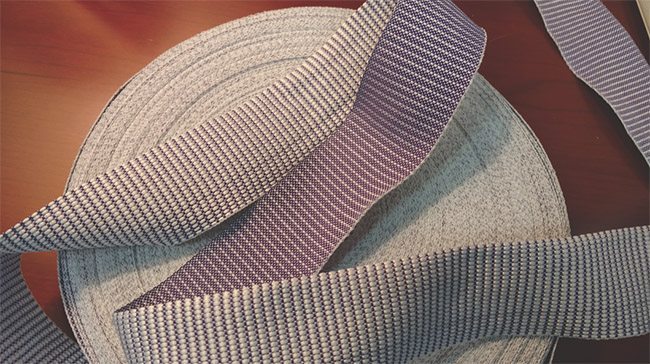
While the majority of tapes have one ‘true’ side, the Regency Woven from Bechik Products Inc. has two functional sides, offering greater design versatility. Bechik is headquartered in Eagen, Minnesota.
Bechik Products Inc., with headquarters in Eagen, Minnesota, supplies mattress makers with a wide selection of tape and ribbon, as well as a range of soft goods and hard goods, which include thread, tufting supplies, zippers corner guards, ventilators and more. Family owned since 1932, the company began as a cord-handle supplier and has evolved along with the industry it serves.
“By 2007, our principal focus had become mattress tape with about 65% of current revenues now in the tape and ribbon category,” says President Bill Simon. The Bechik product lineup is manufactured at the company’s Minnesota facility and consists of 190 SKUs of woven and knit mattress tapes alone, in a range of stock colors. In addition, the company offers custom programs and colors with quick turnaround, Simon adds.
Decorative border ribbons can be printed using the company’s heat-transfer or silk-screen printing capabilities. Tapes and ribbons are offered in standard, as well as custom widths.
Bo-Buck Mills Inc.
-
Headquarters: Chesterfield, South Carolina
-
Contact: Dennis Ricketts, sales manager
-
Phone: 843-623-2158
-
Email: [email protected]
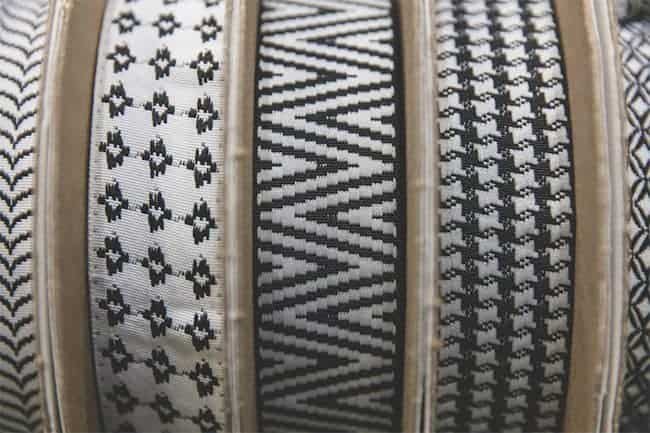
Black-and-white looks are big on today’s beds. Chesterfield, South Carolina-based Bo-Buck Mills Inc. showed this selection of coordinating tapes at ISPA EXPO 2016.
Bo-Buck Mills Inc., which was founded in 1952 by the father-in-law of current Chief Executive Officer Gary Richert, focuses principally on narrow fabrics used as binding tape, trim and mattress handles.
The company’s original plant at its headquarters in Chesterfield, South Carolina, has quintupled in size through the years to more than 65,000 square feet and is in the midst of another expansion, Richert says.
“We changed the industry in 2006 when we hired designers. No longer just a closing tape, the goal was to create tapes that highlight or accent the mattress ‘like jewelry on a lady,’ ” Richert says. “Mattress closing tape—followed by thread—may sit at the bottom of the food chain when it comes to the costs of mattress components, but you can’t put the mattress together without us.”
Bo-Buck Mills manufactures knit and woven tapes in widths from 1/4 inch to 8 inches. Manufacturers generally buy wider tape for fabricating mattress handles. The company is exploring in-house production of sewn handles.
In addition to knitting and weaving tape and ribbon with combinations of polyester and polypropylene yarns, nylon or viscose, the company also makes 100% natural cotton tapes.
BRK Tape & Textiles
-
Headquarters: Pico Rivera, California
-
Contact: Carter Bucklin, sales manager
-
Phone: 800-576-8273
-
Email: [email protected]
-
Contact: Jeff Miller, senior vice president
-
Phone: 800-576-8273
-
Email: [email protected]
BRK Tape & Textiles, based in Pico Rivera, California, is a 20-year-old company supplying mattress tape, ribbon and cord, as well as a range of soft goods for mattress construction. At its California plant, BRK has weaving, knitting, finishing and dying capabilities, as well as cut-and-sew operations. In addition to narrow fabrics, which are available in ½-inch to 3-inch widths, the company produces finished point-of-purchase items, including footers, embroidered pillows and other goods.
Customers can leaf through BRK’s product books and make selections from the company’s existing product line or “they provide us with their chosen fabrics for top and border and we present options for tape, ribbon, handles and label—and sometimes other point-of-purchase items, such as foot protectors,” says Jeff Miller, BRK senior vice president.
Perimeter treatments—whether unadorned solid knits or lush woven logo designs—continue as an important category for the company, Miller says.
CT Nassau Tape-Ticking LLC
-
Headquarters: Alamance, North Carolina
-
Contact: Eric Delaby, executive vice president sales
-
and marketing
-
Phone: 864-431-6096
-
Email: [email protected]
-
Contact: Taber Wood, national account director
-
Phone: 404-307-2095
-
Email: [email protected]
-
Website: CTNassau.com
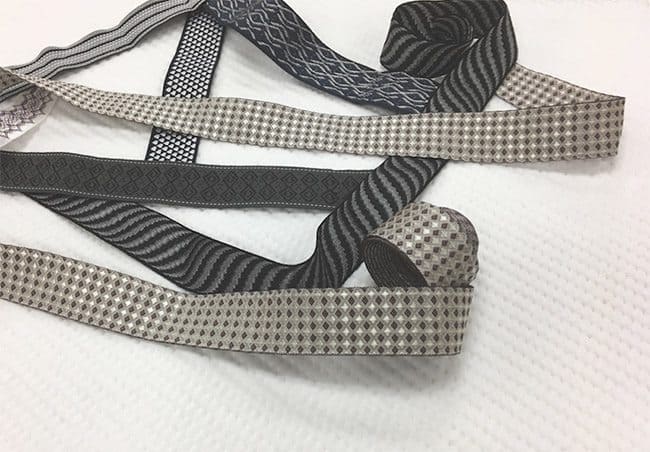
These intricate knit and woven designs are inspired by apparel, says CT Nassau Tape-Ticking LLC, based in Alamance, North Carolina.
CT Nassau Tape-Ticking LLC, with headquarters in Alamance, North Carolina, is the largest U.S. supplier of mattress tape and ribbon, as well as a supplier of circular knit and woven mattress fabrics. As part of the Stellini Group, with international headquarters in Milan, CT Nassau has sister companies with locations around the world, including in Argentina, India, Russia and Thailand. Its tape business dates to 1959, when it was founded in Nassau County, New York.
CT Nassau has repositioned itself in the market as a “design house,” says Eric Delaby, CT Nassau executive vice president of sales and marketing. “We pride ourselves on being a one-stop shop when it comes to mattress aesthetics.”
The open line includes woven and knit tapes in a vast range of qualities and colors, as well as an in-stock program of some of its most popular sellers. The company also specializes in creating custom programs and touts its computerized color-matching system, allowing it to dye woven or knit tapes to perfectly match any mattress accent color.
About five years ago, CT Nassau began manufacturing its own polypropylene yarns, which reduces lead times for just-in-time customer projects.
Reliant Ribbon & Trims Corp.
-
Headquarters: Paterson, New Jersey
-
Contact: Scott Smith, executive vice president of sales
-
Phone: 973-321-9646
-
Email: [email protected]
-
Website: ReliantRibbon.com
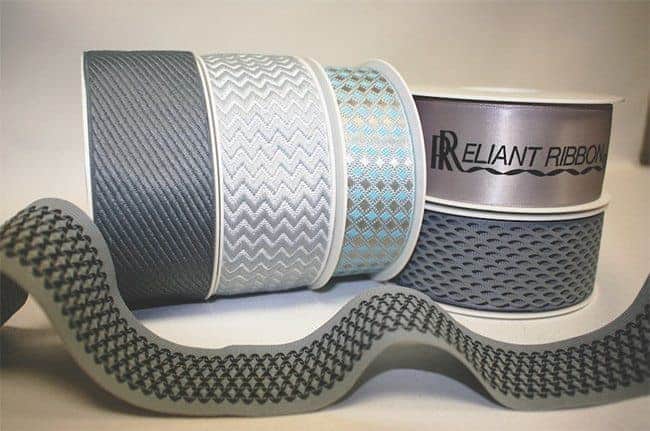
Paterson, New Jersey-based Reliant Ribbon & Trims Corp. offers a range of narrow fabrics for tape edges, decoration and branding, such as this satin printed ribbon, and a selection of knit and woven narrow fabrics.
Since 1963, family-owned Reliant Ribbon & Trims Corp. has been designing, manufacturing, converting, importing and distributing narrow fabrics and trims for a wide range of industries.
The company’s headquarters, manufacturing plant and distribution center are in Paterson, New Jersey. It also operates permanent showrooms at the Americas Mart in Atlanta and at the Dallas Market Center.
Along with custom design and global manufacturing, Reliant offers an extensive in-stock program, with more than 15,000 ribbons and trims in stock every day. The company specializes in custom weaving, knitting, printing and dying of narrow fabrics. Of special interest to mattress manufacturers are Reliant’s textured woven and knit tapes with intricate designs, along with woven or printed logos. There also are newer ribbons that use elastic yarns to add stretch.
In addition to stocking nearly 60 colors of satin, grosgrain and other ribbon and trims, the company can dye product to color-match ribbon with ticking. Ribbons are available in standard widths for the mattress industry, as well as in a wide range of custom widths, from 1/8 inch to 6 inches.
Reliant’s design team travels the world, attending shows and staying abreast of apparel and home furnishings trends, says Scott Smith, executive vice president of sales.
How to Sew a Straight Tape-edge
An evenly sewn tape-edge is essential to a bed’s finished look …
It’s why the most skilled person in a mattress plant is the tape-edge machine operator. It’s also why tape suppliers are hands-on when it comes to assisting manufacturers as they adjust to working with a new tape.
Experienced tape-edge operators may have preferences for working on particular machines with particular tape constructions or yarn types, suppliers say. Some of them find knits easier to work with, says Bill Simon, president of Eagen, Minnesota-based Bechik Products Inc. “(Knits) can help the tape-edge operator with these thick, thick mattresses as he goes around corners. There’s a little bit of stretch with knits and no wrinkling.”
Laura Allred, product manager for AEC Narrow Fabrics in Asheboro, North Carolina, agrees that knits can be “a little bit more forgiving and a bit easier to tailor because of their slight stretch.” They are less likely to ruffle and the tape-edge comes out nice and straight with even corners,” she says.
When working with a new tape, operators need to know how to adjust the tension on the tape and thread, as well as the spool height on the machine—and a lot more. Occasionally, the tape itself needs adjusting, says Jeff Miller, senior vice president of BRK Tape & Textiles, based in Pico Rivera, California. “It must run smoothly and efficiently during production. You have to be proactive—sometimes you must adjust the tape, its width or stiffness. Another big issue is tape splicing.” From ultrasonic welds to tightly sewn seams, BRK has developed different methods of splicing tapes to accommodate different tape constructions, mattress designs and tape-edge machinery, Miller says.
Sewing a consistently neat, straight and strong tape-edge is more of an art than a science, say the experts at thread supplier Coats North America, with headquarters in Charlotte, North Carolina.
The Coats NA technical service team, which consists of Tony Herrington, Kevin Lamb and Doyle Thompson, offers several tips for mattress customers looking to perfect their art:
- First, start with talented operators working on good machinery using high-quality materials.
- In addition, all sewing machines need routine and thorough maintenance, and every operation must be carefully set up and monitored.
Mattress makers need to consider many factors:
- What are the sewing specifications for this particular task (from needle size to optimum thread tension)?
- Is the alignment of the mattress edge with the tape-edge folder and sewing-head feed mechanism just right?
- Is the correct tape-feeding tension applied into the tape-edge folder?
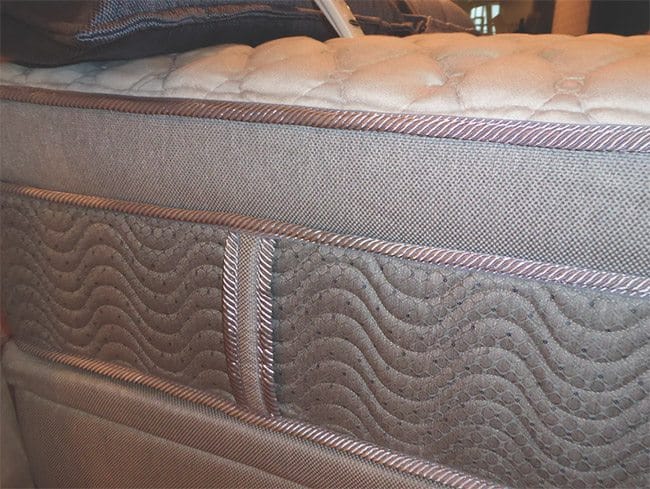
Not two, but three straight lavender tape-edges with lots of sheen embellish the Forever collection from Chicago-based mattress licensing group Englander.
On factory visits, Coats personnel review a 17-item checklist to help tape-edge operators do their best work:
-
Needle-bar setting
-
Looper setting
-
Spreader setting
-
Needle type
-
Looper movement
-
Stitches per inch (minimum is six)
-
Machine speed
-
Parts
-
Feed-dog setting
-
Thread pull-off to monitor proper loop formation
-
Spreader void and motion check
-
Looper-deflector setting review
-
Needle guard
-
Feed synchronization
-
Thread-path guides
-
Are tensions of needle and looper to standards?
-
Tape margin (maintain 1/8-inch stitching margin for best binding appearance).
Fast Facts About Narrow Fabrics
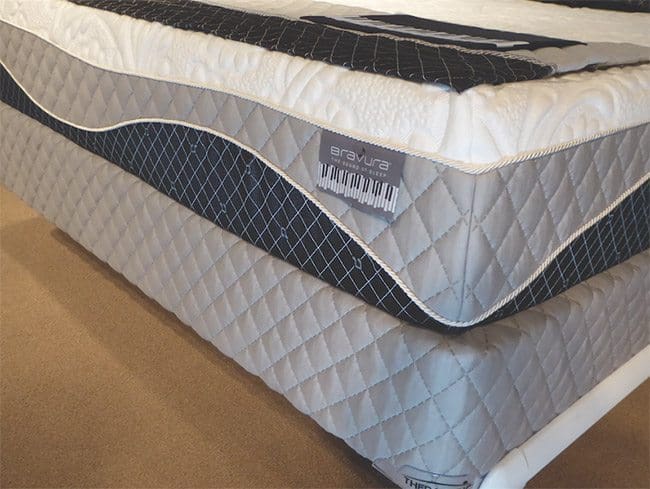
The sewn cover for Princeton, New Jersey-based Therapedic’s Bravura collection, which launched at the Summer Las Vegas Market, uses ‘cording’ on the border, a braided rope trim sewn at the seams.
- Mattress tape sometimes is called binding tape or closing tape. It has a knit or woven construction, a sealed edge and traditionally is used to close a seam on a bed.
- Ribbon is a knit or woven narrow fabric typically used as a decorative element on a bed or point-of-purchase items. (In general, the difference between a ribbon and tape is how it’s used rather than how it’s constructed.)
- Trims are decorative elements, from crystals to tassels. Mattress and foundation trims include ruffled or pleated narrow fabrics, cording, lace and even leather.
- Mattress tape is sold by the gross yard. There are 144 yards in a gross yard and it takes about 14 yards of tape to create two tape edges on a queen-size mattress. Today’s standard mattress-tape width is 1 7/16 inches, although 1¼-inch to full 1½-inch versions are readily available and often used. Narrow fabric offerings can range from 1/8 inch to 6 inches.
- The majority of narrow fabrics used in the bedding industry are a combination of polyester and polypropylene yarns. Also available are 100% polyester tapes, 100% cotton tapes and tapes using various percentages of cotton, nylon or viscose yarns.
*** End ***




